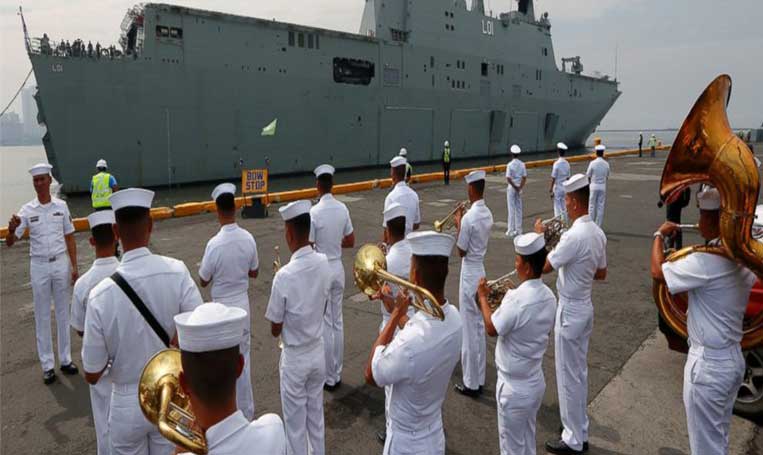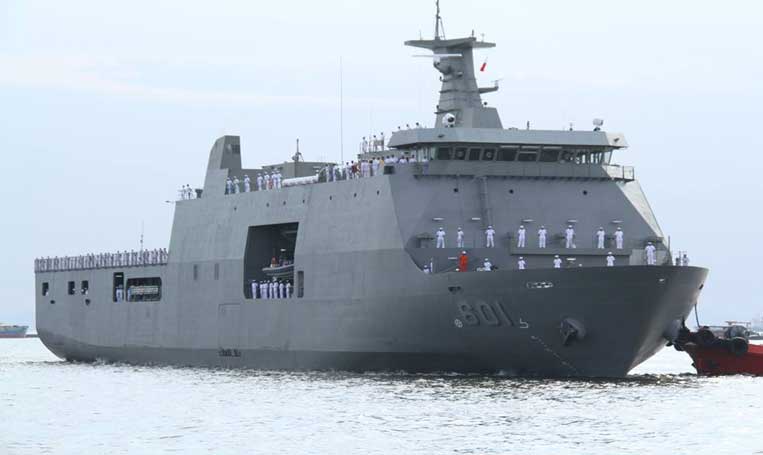Hanjin lands PH in Top 5 shipbuilding countries
Posted 7 years ago
As a former US naval base, Subic is ideal for marine and shipbuilding industries. Its deep waters, calm seas, skilled workforce and attractive incentives for manufacturers in the export processing zone has made it perfect for Hanjin Heavy Industries and Construction Co., Ltd. (HHIC) to expand its operations outside Korea.
“It took us almost two years just scouting for the perfect location. We’ve considered Mindanao and Batangas, but this shooting range area used by US naval personnel was just perfect for a large-scale shipbuilding
 |
| HHIC-Phil President Gwang Suk Chung (seventh from right) is joined by key officials during the launch of CMA CGM
/td> |
complex. I consider it an answer from the heavens,” External Trade Team general manager Nack Young Kim told The Sunday Times Magazine during an exclusive tour of the 300-hectare facility last week.
 |
| External Trade Team General Manager Nack Young Kim and Executive Director Pyung Jong Yu at the Hanjin buildinglocated at the Redondo Peninsula |
The area Kim was referring to is the tip of the Redondo Peninsula – a short mountainous peninsula extending about 15 kilometers to the south of Zambales – separating Subic Bay and the surrounding coasts from the South China Sea. This also forms part of the Subic Bay Freeport Zone.
Hanjin, which means “Korea move forward,” has actually been doing business in the Philippines as early as August 1972, when it built major construction roads in General Santos in Mindanao.
Besides the roads, the company also built the once government flagship project Light Rail Transit (LRT) Line 3 as well as the Philippine National Railways (PNR) project. It also contributed in the improvement of the country’s vital gateways to the world with the successful construction of major airports such as Davao International Airport and Laguindingan Airport including key seaports like Batangas Port and North Harbor under its portfolio.
With the mother company in Korea – which was established in July 1937 – diversifying and expanding its operations from shipbuilding, construction, heavy industries, energy, property development, airlines and logistics services, the Philippines was chosen among other countries in the Asean region for its highly educated and skilled labor force, English fluency and close affinity to the Korean culture, most especially rice as the staple food.
Shipyard established
In 2006, Hanjin established Hanjin Heavy Industries and Construction Philippines, Inc. (HHIC-Phil Inc.) for its shipbuilding business, focusing on manufacturing high value vessels like cargo and container ships, bulk carriers, liquefied petroleum gas carriers, very large crude oil carriers (VLCC) and very large ore carriers (VLOC).
 |
| The French Company CMA CGM’s 20,600 TEU Class Container Ship is among the biggest inthe world manufactured by Hanjin |
The construction of Hanjin Subic Shipyard was completed in record time of less than two years with initial investment of US$1.7 billion. As of 2016, the company’s foreign direct investment stood at US$2.3 billion.
 |
| ALL FOR ONE (from left) Buyer’s Bank representative lawyer Rosevee Paylip-Guiang, Deputy General Manager Ji Min Choo, Navig8 sitemanager Nam Jong Hur, Managing Director Yoo Hoan Jo, team manager Hyung Soo Park, General Manager Jong Yun Ha and GeneralManager Jong Bok Lee |
Although the Korean plant is dedicated to manufacturing combat and coast guard vessels in its Dry Docks 1 to 4, the Redondo facility with its Dry Docks 5 and 6 is gradually gearing up to diversify its product range to include the same types of vessels as the mother company.
“HHIC-Phil will eventually cater to the demand of the Philippine government and other countries for defense-related ships,” Kim explained.
In progress at the shipyard are three 20,600 TEU class container ships, considered among the biggest in the world today. Also being assembled are oil tankers and bulk carriers – catering to customers from the US, France, Spain, Switzerland, Norway, Germany, Singapore and the UK.
The Shipyard Orderbook Monitor ranks the Philippines as the fifth largest shipbuilding country in the world after China, South Korea, Japan and Germany and outperforming Italy, Brazil, Vietnam, France and Finland.
By shipyard, HHIC-Phil is ranked 10th in the world and is at par with other leading shipbuilding companies in Korea, China and Japan.
In December 2009, the Philippine Exporter Foundation (Philexport) awarded HHIC-Phil as Top Export Performer for the period December 2008 to November 2009.
Last year, it received the Top Sectoral Exporter Award from the Department of Trade and Industry.
HHIC-Phil has been consistently thrust in the global spotlight in recent years with its innovative, environment friendly and technologically advanced vessels earning coveted recognitions from industry stakeholders. Just in March this year, the world-recognized Naval Architect magazine awarded HHIC-Phil Best Vessel in 2016 for VLCC M/V Gener8 Hector.
28,000 Filipino workers
Hanjin Subic Shipyard is not just the largest manufacturing facility in the country but also one of the biggest employers with 28,000 Filipinos working on two shifts and hundreds of Koreans, Chinese and Romanians among its mid-level executives and skilled staff.
Executive director Pyung Jong Yu told The Sunday Times Magazine that one of the admirable qualities of Filipino workers is their trainability and adaptability.
“Filipinos easily acquire skills. Their dedication to their work can also be attributed to their love for their family,” he said.
Asked about the downside of sending Filipinos to Korea for further training, Yu said that many of those who were sent out would not want to come back anymore as they either became engrossed to the Korean standard of living or they literally jumped ship with other companies there, adding that such situation was somehow counter-productive in the process since the Philippines has enormous potentials in expanding its footprint in the global shipbuilding arena which is considered an industry vested with national interest in major economies like Korea and Japan.
Nevertheless, many of the Filipino workers at the Subic Shipyard have been with the company 10 years or 11 years. One of them is Dry Dock 6 Assistant Manager Anjelo Ajeno. He said that staying in Korea or jumping to another shipping company after his training in the HHIC headquarters never crossed his mind. And he is glad he was not tempted to do so because his present position is comparable to top management positions in other companies.
On labor union issues
Citing the news items that came out in The Manila Times in September and over the week, the External Team general manager said they are not averse to labor unions set up in Hanjin Subic Shipyard. In fact, he was a union leader himself back in the mother company in Korea.
 |
| Hanjin’s 30-hectare housing project in Castillejos is now 67-percent occupied |
“Labor union has its own merits, but it may perhaps do good if such organizations come within the Hanjin Subic Shipyard that are not affiliated with groups with political or militant leanings,” Kim told The Sunday Times Magazine.
“Every stakeholder should be careful since there had been big companies like Nike Philippines that got disrupted due to demands of the labor union. Regrettably, the global shipbuilding industry has been affected by recession since 2010 and HHIC-Phil is no exception. Enormous challenges still lie ahead and we need to work together as one to overcome the difficulties in the years to come. Until such time, any form of disruption would only bring negative impact on our overall shipbuilding activities that tens of thousands of workers and their families heavily rely on for their source of livelihood,” he further explained.
“We told the workers to keep their position, where they are right now, because when we get out of the red, everyone will benefit. We asked them to prioritize needs over wants, and think of the future of their families,” Yu chimed in.
Meanwhile, External Trade Team section chief Peter Paul Bonifacio who had been with Hanjin Subic Shipyard for more than 10 years informed The Sunday Times Magazine that the news report saying that 30,000 Hanjin Shipyard workers were already union members was misleading.
“The recent declaration of the failure of certification election by DOLE proved nothing but showed that the overwhelming majority of our fellow workers are not indeed union members and simply wanted to work hard for a decent living for the benefit of their families in the long term,” he said, adding that they wanted to set the record straight.
Employee benefits
HHIC-Phil is perhaps one of the few companies in the Philippines providing free lunch for all its almost 30,000 workers – from top management to sub-contractor workers – and additional meals for those working overtime, spending P44 million a month for it.
Shuttle buses, jeepneys, bancas and its own RORO (roll-on roll-off) vessels are provided for the workers to and from Olongapo City, averaging P25.78 million monthly on transportation expenses for the company. Haircut is likewise free.
The company also extends support to the operation of Redondo Peninsula Multi-Purpose Cooperative Inc. (RMPCI) in helping uplift the livelihood and welfare of the employees through low-interest loans, reasonably priced groceries and annual dividends.
As added incentive, HHIC-Phil also allots a budget for Perfect Attendance Allowance, Welding Allowances (which is the bulk of work in the shipyard), Position Allowance and a guaranteed salary increase based on merit.
Moreover, covering 30 hectares and 19 kilometers away from the Hanjin Shipyard is a housing project – in cooperation with Pag-Ibig Fund – in Castillejos as part of its social responsibility. The 1,722 units is 67-percent occupied as of this writing.
Likewise, HHIC-Phil conducts medical and dental mission twice a year in the surrounding communities and has donated land and buildings to the Department of Education benefiting children of workers and residents of nearby areas.
Manpower development
Being a large-scale enterprise in a labor-intensive industry, Hanjin requires highly specialized skills and technical expertise. A large chunk of its multi-billion dollar direct investment goes to manpower development.
The company-run Skill Development Center (SDC) inside SBMA has graduated 43,778 trainees since 2006, mostly welders. Although the bulk of trainees come from the province and nearby areas, there is also a good number from the Visayas and Mindano. Courses include Assembly, Marking, Fit-Up, Pre-Outfitting, Electrical Outfitting, Crane Operation, Material Control. Outfitting, Painting, Hull Piping, Machinery Outfitting and Design
Lectures are conducted by both Filipino and Korean trainers.
111th vessel delivered
On October 9, HHIC-Phil Inc. delivered its 111th vessel, a 300,000 DWT class Very Large Crude Oil Carrier (VLCC), completely manufactured in the Redondo Shipyard.
Named M/V Gener8 Nestor, the vessel was launched on December 29, 2016. The turnover, witnessed by representatives of the customer and the company, cemented HHIC-Phil’s position in the global shipbuilding arena as the builder of choice for such type of commercial vessel which requires craftsmanship of the highest standard to be built successfully.
 |
| Former president Gloria Macapagal-Arroyo named the first Subic-made maiden vesselArgolikos in July 2008 |
The brand new ship adds to the growing international fleet of shipping conglomerates Gener8 and Navig8 with headquarters in the US and Singapore, respectively. It is the second VLCC class to be delivered by HHIC-Phil Inc. to the conglomerates after the successful turnover in December 2016 of M/V Gener8 Hector, which was the first-ever Philippine-made VLCC.
Powered by MAN 7g80ME-C9-2 engine, M/V Gener8 Nestor tilts the scale with a total deadweight tonnage of 297,637 metric tons and measures 321.924 meters in length and 60 meters in width. The vessel will enter service under the homeport of Monrovia.
“With its storage tank of unprecedented proportion, M/V Gener8 Nestor could load up to 300,000 metric tons of precious crude oil to any destination in the world, or roughly equivalent to the entire Philippines’13-day fuel supply requirement in 2015. The Philippines sourced from overseas 65.14 million barrels of crude oil or 8.88 million metric tons that year,” HHIC-Phil president Gwang Suk Chung explained the vessel’s capacity.
In June of this year, HHIC-Phil Inc. delivered VLCC class M/V TRF Hudson to its proud Norwegian-based ship owner Transportation Recovery Fund LP.
“VLCC class vessel is fast becoming the workhorse for the shipping industry especially engaged in the transport and logistics needs of the multi-billion dollar oil industry to fill in the global supply chain,” the shipbuilding company president explained.
“With our 28,000-strong highly skilled workforce, Hanjin Subic Shipyard is resilient as ever and more than capable of meeting the ever changing requirements of both industries for highly efficient and environment friendly vessels that are rapidly shaping the landscape of the future of the international maritime community,” he added.
HHIC-Phil Inc. has already delivered 111 vessels to overseas clients since July 2008, with an estimated export value of US$7 billion, barely 10 years since it started operations.
On to the future
The ship manufacturing company is presently fabricating a number of high value vessels including three 20,600 TEU class containerships considered among the biggest in the world today. The company expects a steady stream of vessel deliveries this year onward.
The company’s portfolio includes bulk carrier, ultra large containership, liquefied petroleum gas, crude oil tanker, very large crude oil carrier and very large ore carrier.
Maximizing its long experience and accumulated technology, HHIC-Phil Inc. is gradually gearing up to diversify its product range to include the manufacture of combat and coast guard vessels to meet the demand of the Philippine government and other foreign states for defense-related ships.
The sheer magnitude of HHIC-Phil Inc.’s shipbuilding activities has revitalized the local economy in Central Luzon in terms of employment generation and creation of various livelihood opportunities for local residents, directly benefiting more than 28,000 workers and their families.
The executives informed The Sunday Times Magazine that it takes six to 16 months to build a ship with an average cost of US$60 million depending on vessel type and size.
Source: manilatimes.net/a>













































Loading Comment